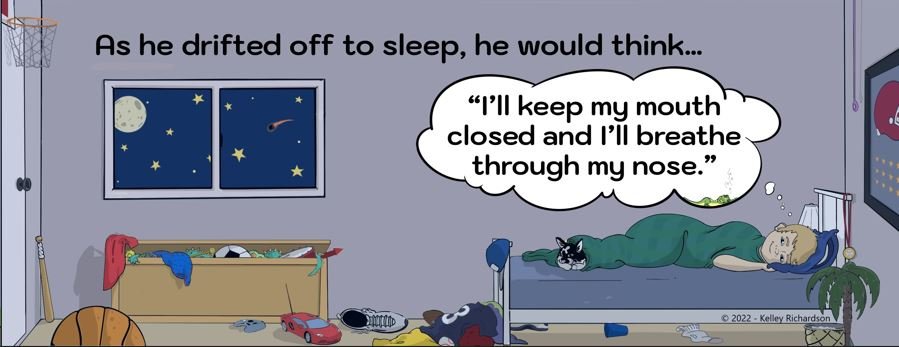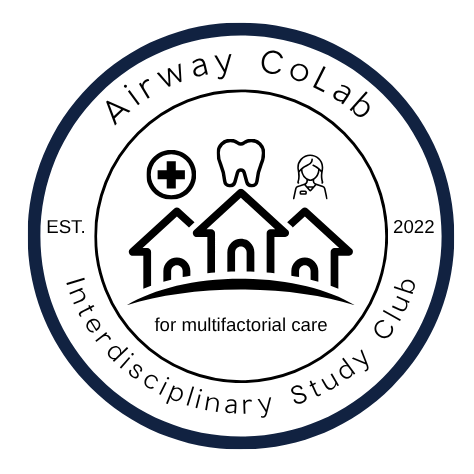The Power of Nasal Breathing
For Parents & Teachers
Many families and educators are surprised to learn that not all breathing is healthy breathing – and not all sleep is restorative. In fact, how a child breathes during their early years can have a profound impact on their development, focus, mood, and long-term health.
Take mouth breathing, for example. It often starts innocently during a cold, but if left unaddressed, it can become a habit that affects:
Facial development
Airway function
Sleep quality
Daily energy and behavior
Over time, mouth breathing and chronic congestion can lead to real challenges – like restless sleep, snoring, or even enlarged tonsils and adenoids.

The Hidden Signs of Poor Sleep
If a child frequently struggles with nasal congestion (often made worse by dust, dairy, or allergies), it can lead to:
Tossing and turning
Bedwetting
Nightmares or night terrors
Excessive sweating
Snoring
Fragmented, restless sleep
These issues are more than just nighttime nuisances – they can signal an obstructed airway. When the brain senses reduced oxygen, it may release cortisol (the stress hormone), which disrupts sleep even further.
Daytime Red Flags
Lack of quality sleep doesn’t just stay in the bedroom. You may notice:
Sleepiness during the day
Difficulty concentrating
Hyperactivity
Behavior that mimics ADD/ADHD
Long-Term Health Starts Now
We partner with forward-thinking pediatricians and dentists who are passionate about treating the root causes – not just the symptoms. With early awareness and simple interventions, children can avoid a lifetime of issues like:
Sleep apnea
Snoring
Cardiovascular risks
Explore our White Papers to learn more, and let’s start the conversation about nasal breathing and whole-body health – together.
Super Breathing
Start Your Child’s Journey to Better Health – One Breath at a Time
Understanding how your child breathes is a powerful first step toward supporting their lifelong health. Surprisingly, breathing habits often show up not just in how a child looks, but in how they behave.
Behavior Clues That May Signal a Breathing Disorder:
- Mouth breathing (even during the day)
- Anxiety or irritability
- Difficulty focusing or frequent daydreaming
- Daytime fatigue or frequent naps
- Asthma-like symptoms
- Loud, heavy, or chest-based breathing
- Dry mouth or sore throat
- Frequent cavities (not related to sugar)
- Thumb sucking
Physical Signs to Watch For:
- Persistent nasal congestion
- Receded chin or narrow jaw
- Eczema or other skin issues
- Speech delays or impediments
- Tongue-tie or frequent ear infections
- Crowded teeth, buck teeth, or early dental issues
- Lack of spacing between baby teeth
- Crossbite or open bite
- Dark under-eye circles
- Weight gain or difficulty maintaining a healthy weight
What You Can Do
- Nighttime oral appliances can help prevent mouth breathing during sleep
- Myofunctional therapy retrains oral and facial muscles
- Breathing retraining (such as the Buteyko Method) teaches your child to breathe properly through the nose
These interventions can dramatically improve your child’s breathing, sleep, and overall well-being.
Why Breathing and Sleep Go Hand-in-Hand
Many children today unknowingly struggle with disordered breathing, which can sabotage their sleep, energy levels, and development. Unlike past generations, our modern diets and habits can narrow the airway, making it harder to breathe properly – especially at night.
Poor breathing = Poor sleep = Developmental setbacks.
Restful, nasal breathing during sleep is essential for brain health, behavior, growth, and emotional regulation. And the good news? It’s fixable – especially when caught early.
Our Mission at Super Breathers
We’re here to help parents and teachers recognize the signs of mouth breathing early – before it leads to bigger problems. Our goal is to connect families with the right tools, research, and professionals to support better breathing, deeper sleep, and healthier development.
Let’s start the conversation. Let’s build a healthier future, one breath at a time.

Restorative Sleep
Why Breathing Habits Shape Your Child’s Sleep – and Their Future
How your child breathes affects how well they sleep – and sleep is the foundation of their health, mood, behavior, and learning. Today’s modern lifestyle has quietly changed how we breathe, often for the worse. This shift has led to what experts now call Disordered Breathing, and it’s more common in children than you might think.
Before processed foods and screen time, our ancestors naturally developed wide airways and healthy breathing patterns. But today, poor posture, soft diets, and chronic congestion can cause our kids’ airways to narrow, leading to inflammation, snoring, restless sleep, and mouth breathing – all of which disrupt vital sleep cycles and brain function.
Breathing shapes sleep. Sleep shapes development. And development shapes everything else.
At Super Breathers, we’re on a mission to help families and educators understand this critical connection. We equip parents, teachers, and healthcare providers with the knowledge and tools to:
- Spot the early signs of mouth breathing and airway issues
- Understand the link between breathing and sleep quality
- Connect with trusted professionals for diagnosis and treatment
With early awareness and the right support, you can help your child breathe better, sleep deeper, and thrive in every area of life.
How Your Child’s Diet, Breathing, and Sleep Are All Connected
Before the industrial revolution, children chewed tough, unprocessed foods like dried meats and nuts starting at just 6 months old. This natural chewing action strengthened jaw muscles and helped create a wide, roomy dental arch – one that fit all 32 adult teeth without braces. But today’s soft, processed foods don’t challenge the jaw the same way, and it shows.
A weak jaw often leads to a narrow dental arch and a high palate. When the palate is too high, the tongue can’t stay suctioned to the roof of the mouth – where it’s supposed to rest. This causes the tongue to sit low in the mouth. Since the roof of the mouth is also the floor of the nasal passage, a high palate can shrink that space, making it harder to breathe through the nose. Add in tongue ties or allergies, and mouth breathing often becomes the norm.
Signs of Sleep-Disordered Breathing (SDB)
Look for these common signs in children – they may seem subtle, but they can be strong clues that your child isn’t sleeping or breathing well:
- Excess energy before bedtime (wired, not tired)
- Heavy sweating during sleep
- Snoring or noisy breathing
- Restless sleep or tossing and turning
- Bedwetting
- Frequent night waking
- Nightmares or night terrors
Poor sleep doesn’t just stay in the bedroom. It shows up the next day as congestion, irritability, inflammation, trouble focusing, and emotional ups and downs.
What Happens During Sleep
Restorative sleep has four crucial stages that support the body and brain. Each one plays a role in memory, immune health, emotional regulation, and physical development. (For a great visual, check out the slide “There’s a Lot Going On During Sleep” in Sleep Wrecked Kids by Sharon Moore.)
How to Promote Better Sleep and Breathing
Simple habits can make a big difference in your child’s breathing and sleep:
- Rinse sinuses with saline before bed
- Use Breathe Right® nasal strips for clearer airways
- Limit screen time and blue light exposure in the evening
- Keep the bedroom cool, dark, and distraction-free
- Use an oral appliance (under professional guidance) to support nasal breathing, lip seal, and proper tongue posture
Left untreated, mouth breathing and fragmented sleep can contribute to inflamed tonsils, enlarged adenoids, and eventually conditions like:
- Chronic snoring
- Sleep apnea
- High blood pressure
- Heart disease
- Long-term CPAP machine use in adulthood
Hope Starts with Awareness
Your child’s behavior and physical traits are full of clues. By noticing patterns early and choosing proactive solutions, you can support healthy breathing habits that lead to deeper, more restorative sleep – and a brighter, healthier future.

Healthier Life
Understanding the Power of Healthy Breathing
Awareness around the difference between mouth and nose breathing is growing – and for good reason. It reflects a shift toward taking personal responsibility for our long-term health through simple, everyday habits.
With a basic understanding of how breathing and sleep are connected, families and individuals can take proactive steps to reduce their risk of serious conditions like sleep apnea, diabetes, high blood pressure, stroke, and even dementia.
The path to better health begins by addressing the root causes of chronic inflammation, nasal congestion, and habitual mouth breathing – and by making small, meaningful changes that support deeper, more restorative sleep.
Next Steps
Take the First Step Toward Better Breathing and Restful Sleep
Improving your breathing and sleep starts with a few simple, intentional steps. Here’s how to begin:
Contact Us
Have questions or need guidance? Reach out to our team, or schedule a consultation to get personalized support.Schedule a Dental Evaluation
Make an appointment with a dentist who understands airway health and can screen for sleep-related issues. Many collaborate with Myofunctional Therapists – or you can contact a local therapist directly and ask for a referral.Learn About Myofunctional Therapy
Explore this proven approach to addressing breathing and sleep challenges. You can also try the Oxygen Advantage app to start practicing simple breathing exercises at home.Explore Recommended Reading
Dive deeper into breathing, sleep, and health with expert-recommended books. These resources are a great way to build your knowledge and confidence.Browse Our Recommended Products
From nasal strips to oral appliances, these curated products can support your journey to better breathing and higher-quality sleep.
Making these changes can help you or your child breathe better, sleep better, and feel better – every single day.

SUPER BREATHERS® LLC PROVIDES THE INFORMATION ON THIS PAGE FOR EDUCATIONAL PURPOSES ONLY
All content found on the superbreathers.com website, including text, images, video, or other formats were created for informational purposes only. The content of this website is not intended to be a substitute for professional medical advice, diagnosis, or treatment. Always seek the advice of your physician or other qualified health provider with any questions you may have regarding a medical condition. Never disregard professional medical advice or delay in seeking it because of something you have read on this website.
© 2025 by Kelley Richardson | SuperBreathers, LLC

